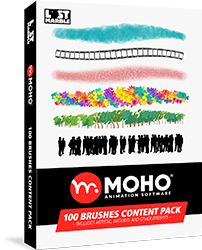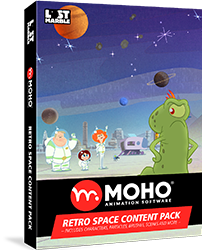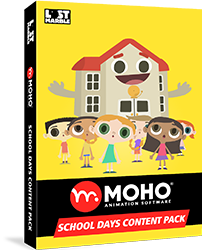
Moho Featured Artist: Amblagar Studio
Mario Quinones @
This week our Moho Featured Artist is the very talented animation studio Amblagar! 🔥 They use Moho as their main 2D animation software ✨
Tell us about you
Amblagar Studio was born in 2002 from the will of two friends to tell meaningful stories. It was focused on creating comics at first, planning to create a full-featured animated film someday. The studio's capabilities evolved over the years: ranging from producing video games for Disney, Nick, and Cartoon Network, to creating broadcast motion graphics and brand packages (NatGeo, FOX, PlayboyTV, and others), to more character-driven animation projects.
Back in 2008, Amblagar was chosen to create a 30' pilot for an animated tv series produced in Miami. We intended to do it all in After Effects but soon found out that there were so many characters both animals and humans to rig and animate. That's when we jumped into Moho (it was called "Anime Studio 5" at that time). We used it to solve almost half of all character animation in the pilot, with great results. We were so amazed by what we could achieve in such a fast way that we started calling it "TAS-5" as an internal code for our "secret superpower".
Where do you get inspiration?
Without a doubt, Cartoon Saloon is one of the animation studios that inspire us the most, both for its artistic quality and its exquisite animation, as well as for using Moho in its productions. Puffin Rock has been a great resource to understand a collaborative Moho pipeline.
Another inexhaustible source is social media: Instagram, Behance, etc. We are always finding new artists, paintings, animations, techniques, and tutorials.
And in broader areas, a source of inspiration is yoga.
What’s your hardware setup?
- PC Intel(R) Core(TM) i7-6700 CPU @ 3.40GHz, 16 GB de RAM,Tarjeta de Video NVIDIA GeForce GTX 1050
- MacBook Pro
What do you like best about Moho?
It's difficult to limit this choice to one or two features. What we dig a lot about Moho is being able to save not only full-body actions (running, jumping, facial expressions, etc) but also small actions such as turning a character's head, torso, and feet and using it over and over again with just the rotation of a Smart Bone and at the same time combine them with other Bones allowing a range of immense possibilities in movements. We also like how intuitive Moho is, both in its interface and in its tools, allowing artists to easily start animating almost from the very beginning of their Moho learning path.
How has Moho helped you in your creative process?
In each of our projects, we seek to challenge ourselves, investigate new styles and graphic proposals, and Moho has always been at the service of that search. It has even strengthened and expanded our creative process. Moho's rigging system is so powerful, it provides so many possibilities, that it makes our exploration for each project to be guaranteed entertaining and fun in the process.
Moreover, it allows us to create different production pipelines that range from low-cost animation to complex, higher-budget ones that at times are hard to distinguish from frame-by-frame animation.
What’s your favorite project made with Moho?
Well, our favorite one would be our latest project, an animated series called "Yoga for Kids". These series are based on the book collection we are publishing under the name "Yoga para Peques" in Spanish written by Lucrecia, the director of the studio, who is a yoga teacher. The main character is a little girl called Mina that is playing in her room and shows her teddies how to do yoga. The asanas (yoga postures) she shows are related to a story that she narrates to them. So the chapters have two different graphic languages, the one of the world of Mina and her toys, and the style of the story she tells them.
So for this project, we are developing two sets of parameters in relation to each language. One is related to a kid character with cute proportions (Mina), able of almost a 360 rotation, with a great range of body postures and flexibility to do all the asanas, and with full rig for the mouth and facial expressions. We are using quite an amount of switchable and expandable body parts with Vitruvian Bones.
The other style has to do with richly textured illustrated book scenes, trying to give them a cutout + frame-by-frame animation feel. We created very specific rigs for each scene and not one rig repeats.
How has Moho improved your pipeline workflow?
I would say that even more than improving our workflow it allowed us to engage in projects that otherwise we would have to respond with a solid no!
For example, we produced "Bobo English", a kids' series for China with an outstanding amount of animation to be delivered (up to 80 minutes per month), and it would have been impossible if we hadn't planned it as a Moho-based pipeline. By using character rigs that were being improved along the way, storing them in a server for all animators to be updated with the latest version, and with an ever-increasing actions library we were able to gain production speed and animation quality week by week; in the end we achieved a total of +1100 minutes in 19 months.
Where can we follow your work?
Well, apart from the fact that there are projects that we cannot show due to NDAs with our clients, here's the cliché when we have to say that (fortunately!) we hadn't had time to update our portfolio with all the latest projects, but are working now on our new website and case studies ;)
Instagram: instagram.com/amblagar
Website: amblagar.com
Vimeo: vimeo.com/amblagar


